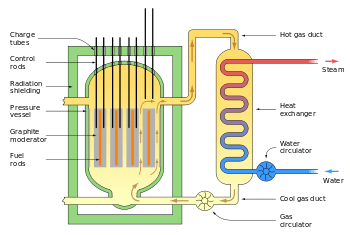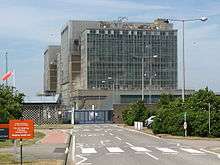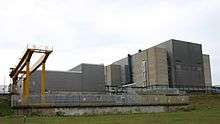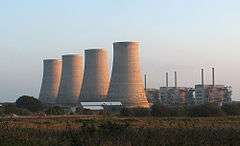Magnox

Magnox is a type of nuclear power/production reactor that was designed to run on natural uranium with graphite as the moderator and carbon dioxide gas as the heat exchange coolant. The title, magnox, comes from the magnesium-aluminium alloy used to clad the fuel rods inside the reactor. In total it was constructed in the tens and sited primarily in Britain during the 1950-70s, with very few exported to other countries. The initial codename for the reactor design amongst the government agency which mandated it, the UKAEA, was the Pressurised Pile Producing Power and Plutonium(PIPPA) and as this codename suggests, the reactor was designed as both a power plant and, when operated with low fuel "burn-up"; as a producer of plutonium-239 for the nascent nuclear weapons program in Britain. This intentional dual-use approach to building electric power-reactors in the early Cold War era was also typical in other nations, now classified, "Generation I nuclear reactors".
In the specific case of the magnox design, the weapons-usable "burn-up" limitations, or plutonium-239 contamination limitations, were informed by the prior 1953 Operation Totem test series of nuclear detonations. The Low-to-interim burnup feature of the reactor design would also go on and become responsible for changes to US regulatory classifications after the, US-UK "Reactor-grade" plutonium detonation test of the 1960s.
It is, primarily, with the operation of a fleet of magnox reactors that Britain has amassed a uniquely massive stockpile of fuel grade/"reactor grade" plutonium, with the aid of the B205 reprocessing facility. A quantity of fuel/"reactor" grade plutonium far greater than in comparison to more typical reactor fleets of the same total energy output. As despite improving its electricity generating capabilities in later decades, marked by the transition to electric-power becoming the primary operational aim, when it is compared with the most widespread power-reactor design magnox reactors were never capable of consistently generating high efficiency/high fuel "burn-ups" due to the handicap of its design and natural uranium heritage.
The first magnox reactor to come online was Calder Hall(at Sellafield) in 1956, frequently regarded as the "first commercial-scale electricity producing reactor in the world", while the last to shut down in Britain occurred in 2015, Wylfa(on Ynys Môn). North Korea remains the only operator to continue using Magnox style reactors as of 2016, at the Yongbyon Nuclear Scientific Research Center.
General description

Magnox reactors are pressurised, carbon dioxide cooled, graphite moderated reactors using natural uranium (i.e., unenriched) as fuel and magnox alloy as fuel cladding. Boron-steel control rods were used. The design was continuously refined, and very few units are identical. Early reactors have steel pressure vessels, while later units (Oldbury and Wylfa) are of prestressed concrete; some are cylindrical in design, but most are spherical. Working pressure varies from 6.9 to 19.35 bar for the steel pressure vessels, and the two prestressed concrete designs operated at 24.8 and 27 bar.[1] No British construction company at the time was large enough to build all the power stations, so various competing consortia were involved, adding to the differences between the stations; for example nearly every power station used a different design of Magnox fuel element.[2]
Online refuelling was considered to be an economically essential part of the design for the civilian Magnox power stations, to maximise power station availability by eliminating refuelling downtime. This was particularly important for Magnox as the unenriched fuel had a low burnup, requiring more frequent changes of fuel than enriched uranium reactors. However the complicated refuelling equipment proved to be less reliable than the reactor systems, and perhaps not advantageous overall.[3]
Economics
The first Magnox reactors at Calder Hall[4] were designed principally to produce plutonium for nuclear weapons.[5] The production of plutonium from uranium by irradiation in a pile generates large quantities of heat which must be disposed of, and so generating steam from this heat, which could be used in a turbine to generate electricity, or as process heat in the nearby Windscale works, was seen as a kind of "free" by-product of an essential process.
The Calder Hall reactors had low efficiency by today's standards, only 18.8%.[6]
The British government decided in 1957 that electricity generation by nuclear power would be promoted, and that there would be a building programme to achieve 5,000 to 6,000 MWe capacity by 1965, a quarter of UK's generating needs.[5] Although Sir John Cockcroft had advised the government that electricity generated by nuclear power would be more expensive than that from coal, the government decided that nuclear power stations as alternatives to coal-fired power stations would be useful to reduce the bargaining power of the coal miners' unions , and so decided to go ahead. In 1960 a government white paper scaled back the building programme to 3,000 MWe,[5] acknowledging that coal generation was 25% cheaper. A government statement to the House of Commons in 1963 stated that nuclear generation was more than twice as expensive as coal. The "plutonium credit" which assigned a value to the plutonium produced was used to improve the economic case,[7] although the operators of the power stations were never paid this credit.
Once removed from the reactor the used fuel elements are stored in cooling ponds (with the exception of Wylfa which has dry stores in a carbon dioxide atmosphere) where the decay heat is transferred to the pond water, and then removed by the pond water circulation, cooling and filtration system. The fact that fuel elements can only be stored for a limited period in water before the Magnox cladding deteriorates, and must therefore inevitably be reprocessed, added to the costs of the Magnox programme.[8]
Later reviews criticised the continuing development project by project instead of standardisation on the most economical design, and for persisting with the development of a reactor which achieved only two export orders.[9]
A retrospective evaluation of costs, using a low 5% discount rate on capital, estimated Magnox electricity costs were nearly 50% higher than coal power stations would have provided.[10]
Safety

The Magnox reactors were considered at the time to have a considerable degree of inherent safety because of their simple design, low power density, and gas coolant. Because of this they were not provided with secondary containment features. A safety design principle at the time was that of the "maximum credible accident", and the assumption was made that if the plant were designed to withstand that, then all other lesser but similar events would be encompassed. Loss of coolant accidents (at least those considered in the design) would not cause large-scale fuel failure as the Magnox cladding would retain the bulk of the radioactive material, assuming the reactor was rapidly shutdown (a SCRAM), because the decay heat could be removed by natural circulation of air. As the coolant is already a gas, explosive pressure buildup from boiling is not a risk, as happened in the catastrophic steam explosion at the Chernobyl accident. Failure of the reactor shutdown system to rapidly shut down the reactor, or failure of natural circulation, was not considered in the design. In 1967 Chapelcross experienced a fuel melt due to restricted gas flow in an individual channel and, although this was dealt with by the station crew without major incident, this event had not been designed or planned for, and the radioactivity released was greater than anticipated during the station design.
In the older steel pressure vessel design, boilers and gas ducting are outside the concrete biological shield. Consequently, this design emits a significant amount of direct gamma and neutron radiation, termed direct "shine", from the reactors. For example, the most exposed members of the public living near Dungeness Magnox reactor in 2002 received 0.56 mSv, over half the International Commission on Radiological Protection recommended maximum radiation dose limit for the public, from direct "shine" alone.[11] The doses from the Oldbury and Wylfa reactors, which have concrete pressure vessels which encapsulate the complete gas circuit, are much lower.
Reactors built

In all, 11 power stations totalling 26 units were built in the United Kingdom where the design originated. In addition, one was exported to Tōkai in Japan[12] and another to Latina in Italy. North Korea also developed their own Magnox reactors, based on the UK design which was made public at an Atoms for Peace conference.
The first Magnox power station, Calder Hall, was the world's first nuclear power station to generate electrical power on an industrial scale[4] (a power station in Obninsk, Russia started supplying the grid in very small non-commercial quantities on 1 December 1954). First connection to the grid was on 27 August 1956, and the plant was officially opened by Queen Elizabeth II on 17 October 1956.[13] When the station closed on 31 March 2003, the first reactor had been in use for nearly 47 years.[14]
The first two stations (Calder Hall and Chapelcross) were originally owned by the UKAEA and primarily used in their early life to produce weapons-grade plutonium, with two fuel loads per year.[15] From 1964 they were mainly used on commercial fuel cycles and in April 1995 the UK Government announced that all production of plutonium for weapons purposes had ceased.[16]
The later and larger units were owned by CEGB and operated on commercial fuel cycles. However Hinkley Point A and two other stations were modified so that weapons-grade plutonium could be extracted for military purposes should the need arise.[17][18]
Derating to reduce corrosion
In early operation it was found that there was significant oxidation of mild steel components by the high temperature carbon dioxide coolant, requiring a reduction in operating temperature and power output. For example, the Latina reactor was derated in 1969 by 24%, from 210 MWe to 160 MWe, by the reduction of operating temperature from 390 to 360 °C.
World's last operating Magnox reactor
The Nuclear Decommissioning Authority (NDA) announced on December 30, 2015 that Wylfa Unit 1 - the world's last operating Magnox reactor - was closed. The unit had generated electricity for five years longer than originally planned. Two units at Wylfa were both scheduled to shut down at the end of 2012, but the NDA decided to shut down Unit 2 in April 2012 so that Unit 1 could continue operating in order to fully utilize existing stocks of fuel, which is no longer being manufactured.[19]
The small 5 MWe experimental reactor, based on the Magnox design, at Yongbyon in North Korea, continues to operate as of 2016.
Magnox definitions
Magnox alloy
Magnox is also the name of an alloy—mainly of magnesium with small amounts of aluminium and other metals—used in cladding unenriched uranium metal fuel with a non-oxidising covering to contain fission products. Magnox is short for Magnesium non-oxidising. This material has the advantage of a low neutron capture cross-section, but has two major disadvantages:
- It limits the maximum temperature, and hence the thermal efficiency, of the plant.
- It reacts with water, preventing long-term storage of spent fuel under water.
Magnox fuel incorporated cooling fins to provide maximum heat transfer despite low operating temperatures, making it expensive to produce. While the use of uranium metal rather than oxide made reprocessing more straightforward and therefore cheaper, the need to reprocess fuel a short time after removal from the reactor meant that the fission product hazard was severe. Expensive remote handling facilities were required to address this danger.
Magnox plants
The term magnox may also loosely refer to:
- Three North Korean reactors, all based on the declassified blueprints of the Calder Hall Magnox reactors:
- A small 5 MWe experimental reactor at Yongbyon, operated from 1986 to 1994, and restarted in 2003. Plutonium from this reactor's spent fuel has been used in the North Korea nuclear weapons program.
- A 50 MWe reactor, also at Yongbyon, whose construction commenced in 1985 but was never finished in accord with the 1994 U.S.-North Korea Agreed Framework.
- A 200 MWe reactor at Taechon, construction of which also halted in 1994.
- Nine UNGG power reactors built in France, all now shut down. These were carbon dioxide-cooled, graphite reactors with natural uranium metal fuel, very similar in design and purpose to the British Magnox reactors except that the fuel cladding was magnesium-zirconium alloy and that the bars were disposed horizontally (instead of vertically for Magnox).
Gas cooled reactors
The accepted term for all of these first-generation, carbon dioxide-cooled, graphite-moderated reactors, including the Magnox and UNGG, is GCR for Gas Cooled Reactor.
The Magnox was replaced in the British power station program by the Advanced gas-cooled reactor or AGR, which was derived from it. A key feature of the AGR was the replacement of magnox cladding to allow higher temperatures and greater thermal efficiency. Stainless steel cladding was adopted after many other alloys had been tried and rejected.
Decommissioning

The Nuclear Decommissioning Authority (NDA) is responsible for the decommissioning of the UK Magnox power plants, at an estimated cost of £12.6 billion. There is currently debate about whether a 25 or 100 year decommissioning strategy should be adopted. After 80 years short-lifetime radioactive material in the defuelled core would have decayed to the point that human access to the reactor structure would be possible, easing dismantling work. A shorter decommissioning strategy would require a fully robotic core dismantling technique.[20]
In addition the Sellafield site which, amongst other activities, reprocessed spent Magnox fuel in its B205 plant, has an estimated decommissioning cost of £31.5 billion. Magnox fuel was produced at Springfields near Preston; estimated decommissioning cost is £371 million. The total cost of decommissioning Magnox activities is likely to exceed £20 billion, averaging about £2 billion per productive reactor site.
Calder Hall was opened in 1956 as the world’s first commercial nuclear power station, and is a significant part of the UK’s industrial heritage. The NDA is considering whether to preserve Calder Hall Reactor 1 as a museum site.
All the UK's Magnox Reactor Sites (apart from Calder Hall) are operated by Magnox Ltd, a Site Licence Company (SLC) of the NDA. Reactor Sites Management Company (RSMC) holds the contract to manage Magnox Ltd on behalf of the NDA. In 2007, RSMC was acquired by American nuclear fuel cycle service provider EnergySolutions from British Nuclear Fuels.[21]
On 1 October 2008, Magnox Electric Ltd separated into two nuclear licensed companies, Magnox North Ltd and Magnox South Ltd.[22]
Magnox North sites
Magnox South sites
In January 2011 Magnox North Ltd and Magnox South Ltd recombined as Magnox Ltd.[23]
List of Magnox reactors in the UK
| Name | Location | Location (GeoHack) | Number of units | Production per unit | Total production | First grid connection | Shut down |
|---|---|---|---|---|---|---|---|
| Calder Hall | near Whitehaven, Cumbria | NY025042 | 4 | 50 MWe | 200 MWe | 1956 | 2003 |
| Chapelcross | near Annan, Dumfries and Galloway | NY2161169707 | 4 | 60 MWe | 240 MWe | 1959 | 2004 |
| Berkeley | Gloucestershire | ST659994 | 2 | 138 MWe | 276 MWe | 1962 | 1989 |
| Bradwell | near Southminster, Essex | TM001087 | 2 | 121 MWe | 242 MWe | 1962 | 2002 |
| Hunterston "A" | between West Kilbride and Fairlie North Ayrshire | NS183513 | 2 | 180 MWe | 360 MWe | 1964 | 1990 |
| Hinkley Point "A" | near Bridgwater, Somerset | TR330623 | 2 | 235 MWe | 470 MWe | 1965 | 1999 |
| Trawsfynydd | Gwynedd | SH690381 | 2 | 195 MWe | 390 MWe | 1965 | 1991 |
| Dungeness "A" | Kent | TR074170 | 2 | 219 MWe | 438 MWe | 1966 | 2006 |
| Sizewell "A" | near Leiston, Suffolk | TM472634 | 2 | 210 MWe | 420 MWe | 1966 | 2006 |
| Oldbury | near Thornbury, South Gloucestershire | ST606945 | 2 | 217 MWe | 434 MWe | 1968 | 2012 |
| Wylfa | Anglesey | SH350937 | 2 | 490 MWe | 980 MWe | 1971 | 2015 |
Magnox reactors exported from the UK
| Name | Location | Number of units | Production per unit | Total production | First grid connection | Shut down |
|---|---|---|---|---|---|---|
| Latina | Italy | 1 | 160 MWe | 160 MWe | 1963 | 1987 following Italian referendum on nuclear power |
| Tokai Mura | Japan | 1 | 166 MWe | 166 MWe | 1966 | 1998 |
See also
| Wikimedia Commons has media related to Magnox (nuclear reactor). |
- Nuclear power in the United Kingdom
- Experimental Breeder Reactor I
- Obninsk Nuclear Power Plant
- UNGG, the similar class of reactors built in France
- Shippingport Atomic Power Station
- List of nuclear reactors
- Edge of Darkness, 1985 British television drama about the nuclear industry, which went by the working title "Magnox".
References
- ↑ Nuclear Installations Inspectorate (September 2000). Report by HM Nuclear Installations Inspectorate on the results of Magnox Long Term Safety Reviews (LTSRs) and Periodic Safety Reviews (PSRs) (PDF) (Report). Health and Safety Executive. p. 27 (Table 3). Retrieved 21 March 2010.
- ↑ "The Magnox Story" (PDF). Springfields Fuels Limited. July 2008. Retrieved 21 March 2010
- ↑ Robert Hawley - former CEO of Nuclear Electric and British Energy (2006). "Nuclear Power in the UK - Past, Present & Future". World Nuclear Association Annual Symosium. Archived from the original on 14 December 2008.
- 1 2 "Calder Hall Power Station" (PDF). The Engineer. 5 October 1956. Retrieved 25 October 2013.
- 1 2 3 Ten Years of Nuclear Power (PDF) (Report). UKAEA. 1966. Retrieved 25 October 2013.
- ↑ Steven B Krivit; Jay H Lehr; Thomas B Kingery, eds. (2011). Nuclear Energy Encyclopedia: Science, Technology, and Applications. Wiley. p. 28. ISBN 978-1-118-04347-9.
- ↑ "Atomic Energy (Civil Use)". Hansard. UK Parliament. 1 November 1955. Hc Deb 1 November 1955 Vol 545 Cc843-4. Retrieved 23 October 2013.
- ↑ Radioactive Waste Management Advisory Committee (November 2000). RWMAC's Advice to Ministers on the Radioactive Waste Implications of Reprocessing, Annex 4: Dry storage and disposal of Magnox spent fuel (Report). Department for Environment, Food and Rural Affairs. Archived from the original on 27 July 2008.
- ↑ S H Wearne and R H Bird (2009, updated February 2010). UK Experience of Consortia Engineering for Nuclear Power Stations (Report). School of Mechanical, Aerospace & Civil Engineering, University of Manchester. Retrieved 19 September 2010. Check date values in:
|date=(help) - ↑ Richard Green (July 1995). "The Cost of Nuclear Power Compared with Alternatives to the Magnox Programme". Oxford Economic Papers. Oxford University Press. 47 (3): 513–24. Retrieved 25 October 2013.
- ↑ Director, Environment Health Safety and Quality. "Discharges and Monitoring of the Environment in the UK - Annual Report 2002" (PDF). BNFL. pp. 7–8,87–88,119–121. Archived from the original (PDF) on 16 November 2004.
- ↑ Tsutomu Nakajima, Kazukiyo Okano and Atsushi Murakami (1965). "Manufacture of Pressure Vessel for Nuclear Power Reactor" (PDF). Fuji Electric Review. Fuji Electric Co. 11 (1). Retrieved 17 April 2014.
- ↑ "Calder Hall Celebrates 40 Years of Operation - Press Release". BNFL. Archived from the original on 22 February 2004. Retrieved 22 February 2004
- ↑ Brown, Paul (21 March 2003). "First nuclear power plant to close". The Guardian. London. Retrieved 12 May 2010.
- ↑ http://www.nautilus.org/archives/pub/ftp/napsnet/papers/hayes1193.txt
- ↑ "Plutonium and Aldermaston - an historical account" (PDF). UK Ministry of Defence. 4 September 2001. Archived from the original (PDF) on 13 December 2006. Retrieved 15 March 2007.
- ↑ David Lowry (13 November 2014). "The world's first 'Nuclear Proliferation Treaty'". Ecologist. Retrieved 2 December 2014.
- ↑ Reginald Maudling (24 June 1958). "Atomic Power Stations (Plutonium Production)". Hansard. UK Parliament. HC Deb 24 June 1958 vol 590 cc246-8. Retrieved 2 December 2014.
the Central Electricity Generating Board has agreed to a small modification in the design of Hinkley Point and of the next two stations in its programme so as to enable plutonium suitable for military purposes to be extracted should the need arise.
- ↑ "World's last operating Magnox reactor closes". World Nuclear News. 31 December 2015. Retrieved 4 January 2016.
- ↑ http://www.sitestakeholdergroups.org.uk/oldbury/upload/oldbury_and_berkeley_joint_meeting_minutes_01_nov_06.pdf#page=7
- ↑ http://www.energysolutions.com/media-center/current-press-releases?viewID=126
- ↑ http://www.magnoxelectric.com/
- ↑ "Magnox Limited". Magnox.
External links
- Magnox Electric
- EnergySolutions
- Nuclear Sites Stakeholder Information - Overview of each Magnox power station, provided by British Nuclear Group
- Magnox Safety Reviews, September 2000, HSE Nuclear Installations Inspectorate
- Magnox Electric plc’s strategy for decommissioning its nuclear licensed sites, February 2002, HSE Nuclear Installations Inspectorate
- The decommissioning of commercial magnox gas cooled reactor power stations in the United Kingdom, G. Holt, Magnox Electric, IAEA meeting paper, 8–10 September 1997
- Operating experience with the Latina Magnox reactor, 21–23 September 1988, Ente Nazionale per l'Energia Electrica
- Review of ageing processes and their influence on Safety and Performance at Wylfa Nuclear Power Station, John Large, 14 March 2001 - includes detailed diagrams
- Magnox Fuel Element Design - Atomic Energy Insights
- Sellafield Magnox cooling ponds cleanup job commences - Nuclear Engineering International
- A ponderous hazard - Nuclear Engineering International
- British Nuclear Group image asset library - A large collection of interior and exterior photographs of all the Magnox power stations in the UK.
- S. E. Jensen and E. Nonbol (Riso National Laboratory) (November 1998). Description of the Magnox Type of Gas Cooled Reactor (MAGNOX) (PDF) (Report). IAEA. ISBN 87-7893-050-2. NKS/RAK-2(97)TR-C5. Retrieved 17 April 2014.